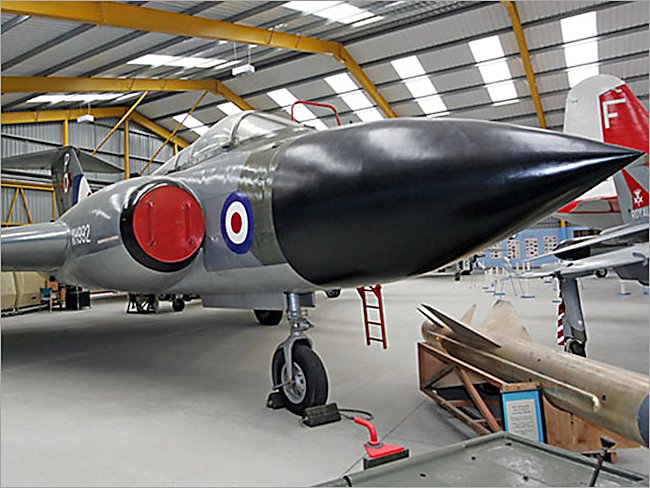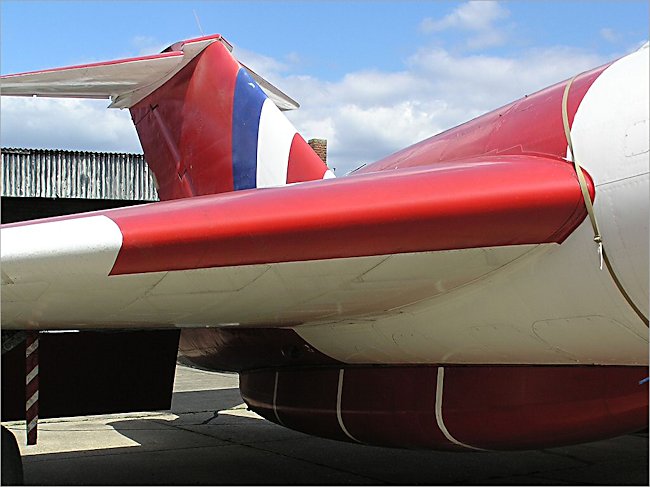Gloster Javelin Interceptor
During the cold war the British Ministry of Defence realised that the United Kingdom was under threat from soviet bombers flying at high altitudes and dropping their bombs through cloud cover guided by means of radar. They needed an all weather night and day jet fighter that could be scrambled to intercept them. The Javelin was part of the RAF British protective shield that provided useful service for over a decade.
The delta winged Gloster Javelin jet fighter could fly faster than the speed of sound and had a ceiling of 50,000 feet. In 1956 14 javelins were delivered to the RAF. The fighter was designated Gloster Javelin FAW Mk1 (Fighter All Weather) It was a very hefty-looking aircraft, built mostly of aircraft aluminum alloys plus some steel fittings, with a broad fuselage, broad and thick delta wings, and a high tee tail with a swept tailfin and a triangular tailplane.

The pilot and radar operator were accommodated in a tandem-seat, air conditioned cockpit under an all-round vision canopy that slid back to open. The Gloster Javelin was powered by twin non-afterburning Armstrong-Siddeley Sapphire Mark 6 (Sa.6) turbojet engines with 36.9 kN (3,765 kgp / 8,000 lbf) thrust each. The jet was continually improved and the FAW.7 variant most closely met the requirements of the RAF and became the most prevalent version. In total Gloster Aircraft Company produced 427 Javelins.
The Gloster Javelin FAW.1 was fitted with Airborne Intercept Mark 17 (AI.17) radar and four 30 millimeter Aden revolver cannon, two mounted in each wing. It was envisaged that the Javelin would eventually have air to air missiles (AAM) armament, but aircraft development outpaced missile development. The missiles of the mid 1950's were not yet reliable enough. The FAW.1 relied on the four cannon for armament.

The Gloster Javelin FAW.2 introduced a new American radar (the APQ.43, instead of the FAW.1's AI.17), with a larger radome, and went into service with 46 and later 89 Squadrons. Initial flight of the first FAW.2 was on 22 October 1955, and 30 FAW.2s were built.
The Gloster Javelin FAW T.3 was a dual control trainer with tandem seating. The initial flight of the first FAW T.3 was on 6 January 1958. 22 were constructed.
The Gloster Javelin FAW.4 was very much like the original Javelin FAW.1 but had the T.3's all-moving tailplane and vortex generators on the wings and entered service with 141 Squadron at RAF Horsham St. Faith, and later with 3, 11, 23, 41, 72 and 87 Squadrons. The initial flight of the FAW.4 was on 19 September 1955, with a total of 50 FAW.4s built
The Gloster Javelin FAW.5 variant was on paper similar to the Javelin FAW.4 but had a redesigned wing interior in order to make room for more fuel. It was intended that four Firestreak air to air missiles (AAM) would be attached to the wings so they were modified to take them but they were never issued.
The Gloster Javelin FAW.6 variant was an upgraded Javelin FAW.2 with the FAW.5 wing improvements. Initial flight was on 15 January 1957 and 33 were built.
The first javelin to actually carry the four missiles specified in the original Air Ministry requirement was the Gloster Javelin FAW.7. Four drop tanks with a capacity of 455 liters (120 US gallons) each could be carried on the pylons for ferry flights. AI.17 radar was retained as was Aden cannon armament, though in many cases two of the four cannon were deleted in the field. Initial flight of the FAW.7 was on 9 November 1956
The mid 1950s was a time of intense technological improvement. The Gloster Javelin FAW.8 was a FAW.7 with reheat ability for extra speed. This new modified jet appeared so quickly that a 80 of the completed FAW.7s were never issued to RAF Squadrons. They went straight into storage at RAF Kemble, and later converted to FAW.9s. The Gloster Javelin FAW.9R, variant was equipped with a large ugly refuelling probe.
Luckily the Gloster Javelin jet fighters never saw action for their primary anti soviet nuclear bomber role. Some did go to Singapore and flew combat air patrols over the Malaysia jungles in 1964. Only 10 Javlins are preserved in various Air Museums. None are air worthy. The Gloster Javelin in the photograph is at RAF Duxford, a branch of the Imperial War Museum, near Cambridge in Central England. It was built as an FAW.7 but was converted to an Gloster Javelin FAW.9. This particular jet fighter was used to accurately calibrated the speed of the Shorts SC.9, Concorde and MRCA Tornado fighter projects. It was the last Javelin to fly. Due to a lack of further orders from the Government, Gloster Aircraft Company closed in 1962.The Gloster Javelin was liked by the pilots because of the amount of weapons it could carry compared with other types in service with the RAF. They also liked its stability and roomy cockpit.
No Javelin ever fired a shot in anger. Records show 19 RAF squadrons flew the Gloster Javelin operating from the UK, West Germany, Cyprus, Singapore, and Zambia. Gloster Javelins occasionally escorted Soviet bombers and patrol aircraft flying through the eastern Mediterranean. In Cyprus Javelins often operated in very tense circumstances due to the tensions between Greece and Turkey. They intercepted Turkish aircraft penetrating Cyprus airspace. Egyptian aircraft were also intercepted by RAF Javelins. FAW.9Rs were deployed to Zambia in late 1965 after Rhodesia declared independence from Britain. Singapore-based Javelins deployed to Malaya to perform border patrols in 1963 because of border tensions between Malaya and Indonesia.
The English Electric Lightning replaced the Javelin in the UK and Germany with most being gone by 1965. The last RAF Javelin squadron was 60 Squadron, disbanding at RAF Tengah on Singapore, at the end of April 1968
Gloster Javelin books


Tweet